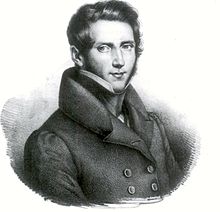Gaetano Donizetti
(1797-1848)

Gaetano Donizetti is one of the three most significant Romantic-era Italian opera composers, alongside Rossini and Bellini. He wrote 65 operas, exploring subgenres like opera seria, opera buffa, opera farsa, and French grand opera. He was essential in developing and innovating the Italian operatic style, especially the bel canto aria.
Donizetti was born November 29, 1797, in Bergamo, Italy, and was first introduced to music at the age of nine. He began attending a free music school directed by Giovanni Simone Mayr, the maestro di cappella at the local cathedral. He studied voice, piano, and composition under Mayr and developed his style from the music of the First Viennese School.
In 1811, Mayr aided Donizetti in his travels to Bologna to study counterpoint with Rossini’s teacher, Padre Stanislao Mattei. Donizetti studied and grew as a composer for six years but did not write any music worthy of public performance. After returning home, he continued to refine his skills by composing works such as cantatas, string quartets, sacred works, sinfonias, and piano pieces.
With Mayr’s help, Donizetti secured a contract to produce a series of operas in Venice. After four years, he accepted an invitation to compose in Rome. His first successful opera, Zoraide di Granata, premiered there in 1822. While working on the production, Donizetti met the Vasselli family, whose daughter, Virginia, he married in 1828. He then accepted an offer in Naples, where he resided and composed two to five operas yearly for the next five years.
Due to his advancing reputation, several Italian cities commissioned Donizetti to compose and premiere operas, including Anna Bolena. The opera’s success brought Donizetti the rise to fame he had been seeking and gave him the courage to pursue other offers. This led to his subsequent success, L’elisir d’amore, which premiered in Milan in 1832.
Donizetti traveled to Rome the following year to produce two of his operas. There, he met Giorgio Ronconi, a young Italian dramatic baritone. Donizetti had not yet composed for Ronconi’s voice type. Their relationship allowed some of the most rewarding performances in their careers, especially Lucrezia Borgia, which premiered at La Scala in Milan in 1833.
Lucia di Lammermoor premiered in 1835 at the San Carlo. It was the biggest hit of Donizetti’s career, resulting in a performance legacy that carries on today. It brought him the acclaim he had aspired for, putting his reputation on the level of his contemporaries.
The late 1830s brought a theme of change. A change for the worse occurred when Donizetti’s parents died within a few weeks of each other between 1835 and 1836. He shifted his compositional style by incorporating various French Grand opera characteristics, as shown in Belisario. Change continued into 1837 when Donizetti’s wife, Virginia, passed on July 30. Grief-stricken, he poured himself into composing, and Roberto Devereux had a successful premiere.
Censorship was a theme throughout Donizetti’s career and was most prevalent in Naples and Rome during the 1830s. Examples of his censored operas include Lucrezia Borgia, Maria Stuarda, and Poliuto. Staging Poliuto in 1838 was the final straw for Donizetti as the censors in Naples refused to compromise on the opera’s religious theme. After he experienced the heavy pain of loss, grief, and professional despondency, he decided to move to Paris. Donizetti did not stage any new works for the first year. Instead, he began to rework Poliuto as Les martyrs, which premiered in 1840. Additionally, he supervised the production of two of his works, Roberto Devereux and L’elisir d’amore, at the Theatre-Italien.
As he found his footing in France, more commissions came to him from Rome, Bologna, and Vienna. In 1842, after he conducted the premiere of Rossini’s Stabat mater, he accepted the positions of Hofkapellmeister to the Habsburg court in Vienna and court composer to the Austrian emperor. He was happy to “settle” into his life, split between France, Austria, and Italy. Donizetti was set apart from Rossini and Bellini because his compositional output increased as the years went on. His crowning work, Don Pasquale, premiered in 1843 and is still often performed today.
Early in the 1840s, Donizetti exhibited symptoms of syphilis, which would ultimately claim his life. As his mental state continued to decline, 1845 marked the last season of his career. In 1846, authorities decided to have Donizetti institutionalized until 1847. His family moved him back home to Bergamo, where he died on April 8, 1848. He is laid to rest close to Mayr at the church of Santa Maria Maggiore.
Click below to view Gaetano Donizetti titles:
t7t3l0uhl8|0010C39D6D07|DetailContent|contenttext|6D76BECB-2098-42A5-85E4-BD6EF4D9653B